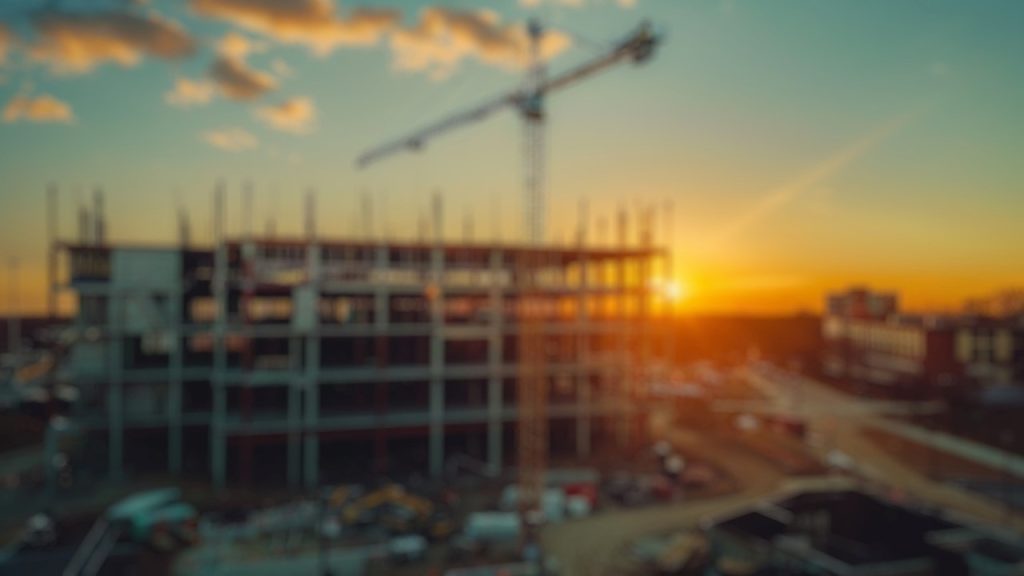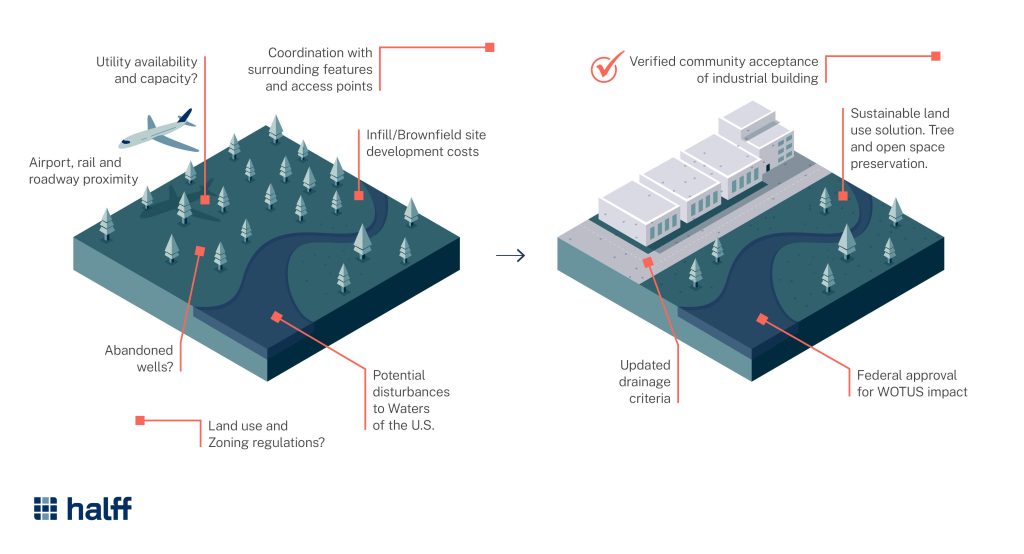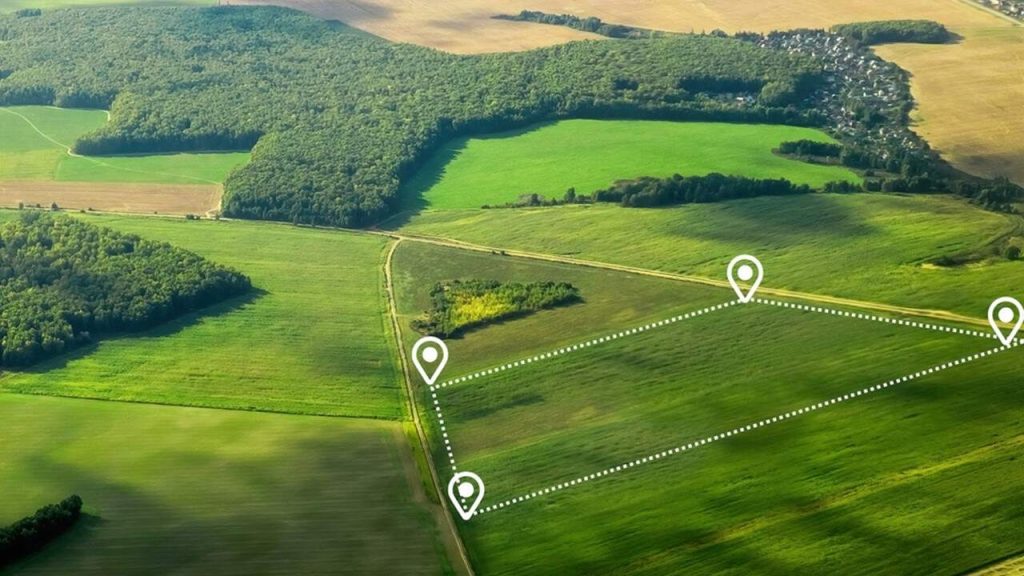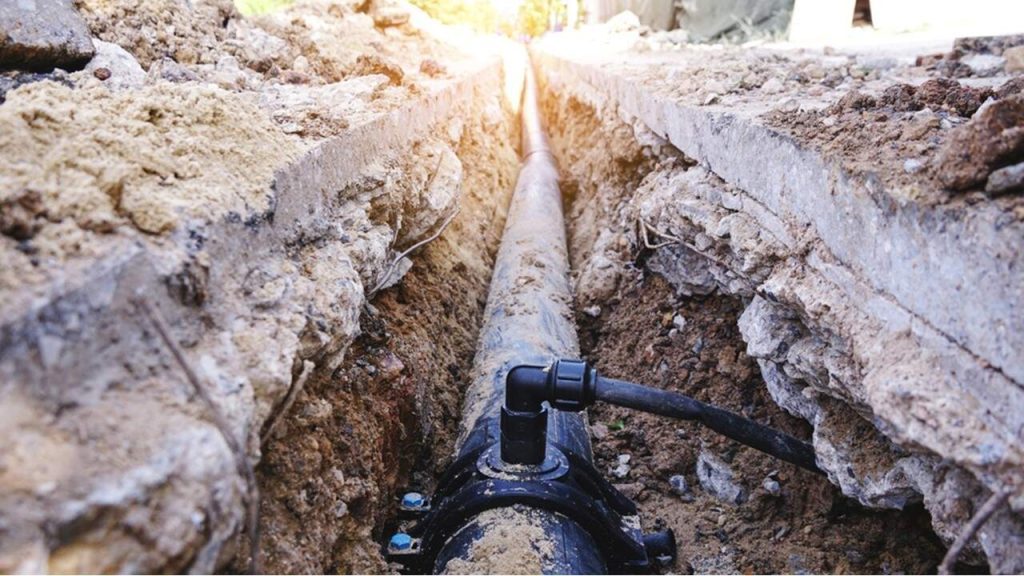3 Challenges in Industrial Land Development in 2025
Industrial land development in 2025 brings its own set of unique challenges.
Ever-changing environmental regulations, limited options for easy greenfield sites, infill/brownfield site requirements and more are being encountered as our rapidly growing economy changes the landscape.
Read about three challenges we’re seeing from a civil perspective, plus other important elements to consider with industrial land development.
- 1. Changing Environmental Regulations
- 2. Greenfield Site Development Challenges
- 3. Infill/Brownfield Site Development Challenges
- 4. Bonus Tips!
1. Changing Environmental Regulations
Meeting all the changing requirements—while staying on schedule and on budget—can be a significant challenge, particularly when new regulations are implemented during the course of development.
Each new administration often brings new environmental regulations, along with updates to defining features within existing regulations. Full understanding of new and current/pending updates is a must.
New Definitions. Waters of the United States (WOTUS) and the Endangered Species Act (ESA) continue to bring new definitions and designations that affect industrial land developments.
One example includes ephemeral streams, which were previously considered a Water of the United States (WOTUS).
Sackett v. EPA (May 2023) has recently narrowed the definition of WOTUS, confirming that federal protections do not extend to many adjacent wetlands and other non-relatively permanent waters (e.g. ephemeral streams).
The Endangered Species Act (ESA) plays a critical role since changes in species listings—like upgrading from “threatened” to “endangered” or adding new species—can suddenly impose stricter mitigation measures and regulations on development. New 2025 listings could halt development in certain areas until new environmental assessments are completed.
Expanding Requirements. Developers must be aware of the expanding requirements in their space. As public and agency focus shifts to resiliency and sustainability issues, a project’s effect on various environmental factors must be addressed.
From an infrastructure perspective, do the roadways, water/wastewater, drainage and electrical grids have the capacity to support industrial operations? Consider open space and tree preservation.
Local governments and regulatory bodies are imposing requirements related to sustainability, resiliency and stormwater management. Green infrastructure may be mandated to mitigate environmental impacts.
Limited Mitigation Options. The availability of mitigation options is diminishing and becoming more costly, as more sites require environmental mitigation. Stricter controls over emissions, water usage, habitat protection, pollution and more pose challenges in balancing development needs with regulations.
As the regulatory landscape evolves, developers need to be mindful of ways they can offset environmental impacts, as not doing so often leads to higher costs and prolonged project timelines.
2. Greenfield Site Development Challenges
Greenfield sites are sites with no development on them. They are often located in newly developing areas.
Land Availability and Financing Costs. Recent inflationary trends, limited inventory and higher financing rates have contributed to increases in land cost. Base cost increases can significantly affect the overall potential for project success, increasing risk on speculative and build-to-suit development projects.
Mitigating factors include securing local, state and federal incentives, partnering with the current landowners, and exploring alternative financing/capital arrangements.
Proximity to Transportation. As available and suitable sites are located farther away from developed infrastructure, costs for improving adjacent roadways and rail facilities become challenging, both from a dollar and time value. State and municipal requirements for transportation infrastructure improvements can place undue time constraints on delivering a finished, ready-to-occupy facility.
Utility Availability. Power, gas, water, wastewater and communication infrastructure must be in place for success. A reliable source of potable water for domestic use, fire protection and manufacturing are very important. Wastewater facilities with sufficient capacity are also necessary.
Alternative strategies for water and wastewater facilities might include on-site water storage for fire protection and on-site wastewater treatment facilities. Solar power facilities and satellite communications could enhance underserved areas and provide resiliency to project facilities.
3. Infill/Brownfield Site Development Challenges
As industrial land becomes more scarce, developers are turning to “fixer-upper” options—infill and brownfield sites. These areas offer the potential for revitalization but come with their own set of challenges that require careful planning and consideration.
What is an infill/brownfield site? An infill or brownfield site is a vacant site that was previously developed, but is now underutilized, abandoned or contaminated. These sites are often located in urban or industrial areas, and present opportunities for redevelopment rather than building on untouched greenfield sites.
Site Preparation, Remediation and Demolition Costs. Infill and redevelopment sites often require costly investments to perform demolition of existing site infrastructure and remediate past environmental issues, due to discovery of unknown underground facilities. The additional risk associated with all these elements are important factors when evaluating an infill/brownfield site for development.
Roadway and Utility Infrastructure Availability/Capacity. Infill sites may experience challenges similar to those in undeveloped areas. The existing infrastructure may have reached its useful lifespan or may be undersized for the proposed facility use.
Age and condition of various roadways and utilities are important factors analogous to lack of these features in undeveloped areas. Aging infrastructure and/or change of use may drastically affect the capacity of various features. Care must be taken to confirm geometry, condition and compliance with current standards while investigating the viability of an infill project.
Larger and more frequent transport vehicles, water/wastewater demands for manufacturing, and robust communications and security requirements need to be taken into account.
Drainage. Updated drainage criteria must be evaluated to confirm compliance with new requirements and resiliency demands. Undersized and/or damaged facilities may impact useable land area. Updated floodplain maps and features may also impact project viability.
Outlier Factors to Consider:
-
-
- Community acceptance and/or opposition
- Sustainability and resiliency factors
- Highest and best use of the land
- Municipality vision
-
4. Bonus Tips: Don’t forget About These Elements!
Below are some often overlooked factors for site development projects:
-
-
- Asbestos: Brownfield sites contain asbestos potential in demolition. Underground fuel storage tanks must be identified and abated.
- Abandoned wells/septic systems: Be sure to check greenfield sites for any abandoned wells and septic systems.
- Cemeteries and cultural resources: These elements may affect both green and brownfield sites.
- Understand zoning regulations: Redevelopment of existing sites may create land use challenges. Zoning changes and implementation of “special” districts and “over-lay” districts will affect uses and functional aspects of the development. Double check to ensure you have all the correct regulations.
- Existing features: Paying attention to the edges, existing features and access points is often an afterthought. Be sure to explore these key elements.
- Airspace coordination: Many industrial sites are located near large and small airports. Coordination with the Federal Aviation Administration (FAA) and other entities will arise, so be sure you are prepared for this.
- Utility transmission facilities: Overhead electric and communication transmission facilities are evident. Oil, gas and communication lines, as well as large diameter water and wastewater transmission facilities could be lurking underground.
- Oil and gas well restrictions: Evaluate proximity to existing oil and gas well features, both active and inactive.
-
Need expert help from Halff? Our talented industry professionals bring years of expertise and knowledge for your projects.
Let Halff help you take the first step by contacting Vice President Dave Littleton (dLittleton@halff.com).









